| |
|
| |
Equine
Directories |
| |
|
| |
|
| |
|
| |
|
| |
Events |
| |
|
| |
Clubs |
| |
|
| |
Classifieds |
| |
|
| |
Articles |
| |
|
| |
Product
Information |
| |
|
| |
|
| |
|
| |
|
| |
|
| |
Contacts |
| |
|
| |
|
| |
|
| |
Legal |
| |
|
| |
|
|
|
Please click on a title below to jump the article.
Horses Need Flax
2
Beet Pulp - Everything
you need to know
Examining Broodmare Nutrition
Fence, Friends & Horses
The Grass is Greener
Nutrition & Caring for the Older
Horse
Horses
Need Flax 2
Just the word alone causes a mental
notion of health. Egyptian physicians knew of the
functional powers of flax thousands of years ago.
Commonly grown as a crop on the prairie, flax is
a plant that grows about two feet high with small
blue flowers. Harvested for food, flax seed is tiny
but yields a nutty taste rich in polyunsaturated
fats (Omega 3&6). For animals,
this is completely relevant as our bodies cannot
manufacture but must obtain from food sources and
even more important, flax is very low in carbohydrates.
In the last article, we discussed the fuel burning
advantages of minimizing the carb intake for horses.
Cleaner burning alternatives act like high test fuel
with fewer by-products produced in the fuel conversion.
If you think of flax being a cleaner fuel like a high
octane, there are fewer toxins or wastes clogging up
the system. A system without excess toxins allows for
thorough oxygen uptake and utilization.
To prepare flaxseed for your horse,
it must be ground, cooked or soaked. The seed hulls
are small and tough and they won’t be chewed
enough to benefit the horse. Flaxseed, either whole
or coarsely ground, appears stable to long-term storage
at room temperature. Ground flax is best stored in
an airtight opaque (no light penetratable) container
to avoid seed becoming rancid or spoiled.
Okay, here I go to try to lay it out for you: Humans
require a diet that is in about a 9:1 ratio of omega
6 to omega 3. With a diet of processed fried North
American food, an obvious lack of omega 3 fatty acids
interrupts bodily processes contributing ultimately
to chronic diseases like cancer, stroke, diabetes and
coronary heart disease. For horses, performance factors
like inflammation, hoof quality and muscling are encouraging
enough to grasp our attention.
I like to think that horses in the
old wild free ranging days found their correct ratio
of fatty acids. Plants rich in omega 3 forming substances
were available in the multitude. Along comes civilization
and we offer them high omega 6 and low omega 3 contributing
grains and cured hay. In meeting the horse’s
nutritional needs for energy, protein, minerals and
vitamins, science has not yet recognized the natural
habitat provided more. More for hoof quality. More
for inflammatory and immunity response. More for
self preservation and flight. I think its time we
started doing the right thing and provided what is
missing and go back to what nature intended.
One apparent sign of your horse’s health is
visibly measured by hair coat and hoof quality. I remember
a study where flax to be proven to help dry, itchy
skin conditions of horse. I will tell you that flax
is a precursor involved in many other process within
the body. A miracle feed, yes? Flax assists other processes
by enhancing and fulfilling the full nutrient requirement.
Sure, without it, the body will get along. If that’s
okay with you, okay, but if you want to maximize performance,
appearance and soundness, then here’s an inside
tip we’re giving you.
Owning a horse or training a horse,
in our minds, it’s the same thing. You are
responsible and should take great pride your horses.
Surely, there are secrets gained from reading or
sharing tips with horsey buddies, but sometimes,
you have to step beyond and have a little faith.
Feeding flax seems to a wonder feed. Hey, the Egyptians
knew it, thousands of years ago flaxt had healing
and health applications. Fed in a ground state, a
stabilized flax supplement contributes missing essential
nutrients. These nutrients are not only lacking in
the diet but are a big part of the equation for the
absorption of other nutrients.
(Information supplied by Andrew Droppo, manager of
Rooney Feeds Ltd. 613-258-1567)

Feeding horses seems to be a complex subject when you think
about all the different types of feed there are today. There
are many different types of feed and just as many different
companies who make feed. Beet pulp is a by-product of the
sugar industry f that is readily available and inexpensive.
The pulps are dried, packaged, and shipped off to all the
feed stores who want it. Greatly used by the dairy and beef
farmers, now the equine industry.
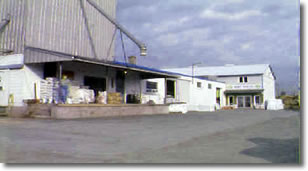 Beet pulp is a highly digestible fibre source. It
has a higher quality of digestible fibre than good quality
hay and a little less than grains. Fibre is the largest component
in a horse's diet. Beet pulp being a high fibre feed can be
substituted as the main fibre source, instead of hay, in a
problem horses diet. Problem horses are; horses who are old
and cannot chew hay properly, have heaves and have to be taken
off hay due to mold and dust, horses who are dehydrated, hard-keepers
(hard to put and keep weight on), horses just getting over
sicknesses and so on. Beet pulp is a highly digestible fibre source. It
has a higher quality of digestible fibre than good quality
hay and a little less than grains. Fibre is the largest component
in a horse's diet. Beet pulp being a high fibre feed can be
substituted as the main fibre source, instead of hay, in a
problem horses diet. Problem horses are; horses who are old
and cannot chew hay properly, have heaves and have to be taken
off hay due to mold and dust, horses who are dehydrated, hard-keepers
(hard to put and keep weight on), horses just getting over
sicknesses and so on.
There are two forms of beet pulp available, shredded and
pellets. The shredded form is usually put into 'complete'
feeds. Now we have it bagged in the shredded form to make
it more convenient to feed. By soaking the shredded pulp it
can be ready within minutes. It seems to be a safe way to
get beet pulp into your horse's diet, especially if you are
uneasy about the pellet. The pellet form is usually soaked
for about 12 hours before it is ready to feed. You would probably
soak it at your 6am feed for the 7-9pm feed and then again
for the morning. There is some controversy about the time
it takes to soak the pellets, but as the old saying goes "It's
better to be safe than sorry". To soak the beet pulp you would,
for example, take one cup of dry beet pulp and put three cups
of water in with it in a bucket. It will expand probably three
times as much as the dry amount you put in.
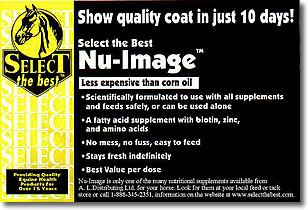 If you are feeding this type of feed to your animals
be sure to include a balanced vitamin and mineral supplement.
Beet pulp is high in calcium but low in phosphorous. This
may disrupt the two to one ratio that is required by the animals
body. It is also low in vitamin B, beta-carotene, and vitamin
D. If you are feeding this type of feed to your animals
be sure to include a balanced vitamin and mineral supplement.
Beet pulp is high in calcium but low in phosphorous. This
may disrupt the two to one ratio that is required by the animals
body. It is also low in vitamin B, beta-carotene, and vitamin
D.
To sum this up, make sure you soak the beet pulp long enough
for the pellets to expand to their maximum capacity. You don't
want to see your horse choke on these pellets, or have them
expand in the horse's intestines or stomach. If you are not
sure talk to your vet or feed specialist on how to feed beet
pulp. Beet pulp can cause choking, and colic, in a worst case
scenarios. The shredded form may turn out to be an easier
route to take if you are really worried about this. Both forms
of beet pulp are available at Rooney Feeds for your convenience.
Information supplied by Michelle Crocker Assistant manager
Rooney Feeds 258-1567
Back to Top

With the foaling season fast approaching, it is time to examine
your broodmare’s feeding program. Ensure that we are
meeting all nutritional requirements to produce strong, healthy
foals. The body conditions of the individual broodmares should
determine all feeding programs. Body scoring is a general
guide to decide the condition of the horses fro extremely
thin (score of 1) to extremely fat (score of 9). Broodmares
should have a body score of 5-6 (moderate to moderately fleshy).
We should not allow Pregnant mares to become fat. This condition
often results in difficulty foaling and may lead to foals
with growth problems associated with overfeeding.
During the first eight months of pregnancy the nutritional
needs are the same as that of a barren mare. In the last trimester
of pregnancy, 60 to 65% of fetal growth occurs. This means
a change to the nutritional requirements of the broodmare.
Mares now have an increased energy requirement and need higher
protein levels. We should feed higher levels of minerals to
ensure proper development of the foal and to prepare the mare
for the higher demands of lactation.
As a general guideline, the levels of concentrates (grains)
should be increased by 10% per month in the last three months
of gestation to meet the energy requirements. Normally by
meeting the energy requirements, they are also meeting the
protein needs. Broodmare rations are usually 14-16% protein.
Fibre is a very important component of your mare’s
daily ration for efficient digestion. Because of fetal growth,
the mare’s digestive capacity is restricted, making
her unable to consume large quantities of bulky feeds. Often
breeders choose a more energy dense fibre source (ie. alfalfa
based hay) to help the mare reach her daily requirements.
The calcium and phosphorus requirements increase greatly during
the last three months to foaling. Their diet should contain
0.5% calcium to 0.35% phosphorus. We should pay attention
to the forages fed to ensure we achieve these levels.
Other minerals needed by broodmares include copper, zinc,
manganese and iron. These are essential for proper bone maturity
and growth. They store these minerals in the fetus during
the last trimester since low mineral levels found in the milk.
During peak production (six to eight weeks after foaling),
a mare can produce 15-20 litres of milk per day. Nutritional
needs increased enormously during early lactation. Mares require
higher energy, protein, calcium and phosphorus levels. Providing
more feed can simply meet the nutritional needs.
Back to Top

 Ah,
the fence is a beautiful creature full of strength and understanding.
Like an old friend, we rely on the fence to perform and hold
a bond of trust. Your fence can be a comforting friend or
a bitter enemy. Ah,
the fence is a beautiful creature full of strength and understanding.
Like an old friend, we rely on the fence to perform and hold
a bond of trust. Your fence can be a comforting friend or
a bitter enemy.
Admitting you have a fencing problem is the first step. While
there are no formal clubs with weekly meetings, your peer
group provides meaningful insight on your requirements. Slipping
your problem into conversation, you find a life of love-hate
fence tips. After a few days, you sit sorting it all out.
You've bared your soul and you now have 12 opinions and each
is different as day is night. While you have not a clue where
to begin, you've certainly gained an insight into what you
want and don't want.
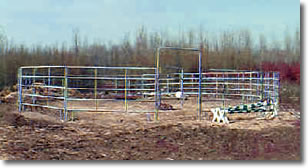 Now you are ready for the second - draw up a plan. This
is a personal journey that only you can travel. Figure out
where you want to go and actually what you want. Are you separating
fields for the pasture rotation? When the weather turns nasty,
have you allowed for a mud area? I s the fence temporary or
permanent? Have you allowed for safety factors? Do you want
a painted look without the painting? It can take as much effort
to make a good fence as it does to make a bad one. Now you are ready for the second - draw up a plan. This
is a personal journey that only you can travel. Figure out
where you want to go and actually what you want. Are you separating
fields for the pasture rotation? When the weather turns nasty,
have you allowed for a mud area? I s the fence temporary or
permanent? Have you allowed for safety factors? Do you want
a painted look without the painting? It can take as much effort
to make a good fence as it does to make a bad one.
Consider the limitations of the land when deciding what materials
yo intend to use. The first thing I ponder is what is under
the soil. Tensile fences require excellent corner and brace
posts. The ability to establish good anchorage is essential.
With no limitations, high tensile options are versatile and
effective fences eliminate costly on going maintenance and
material replacement of traditional post and board fence.
Usually, you will find tensile fences attach to the line posts
so that an animal fence collision allows the whole fence to
stretch and absorb the impact. Rather than a rigid barrier,
the fence line acts as a giant elastic bending to sudden collision
and then returning to its original form.
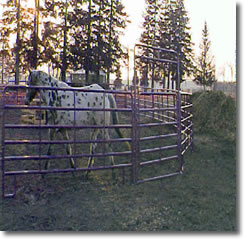 After removing trees and branches for the "ice storm"
of 1998, this permanent fence type performed to expectations
and only required tightening to regain its functionality.
Visibility is the utmost concern of horse fence safety. ExWire
and Flex Rail are unique high tensile products designed for
safe containment. Encased in a polymer plastic, the sight
solidity is increased while eliminating the sharpness of the
wire. Using a spinning jenny, these coils are easy to unwind
and install. A decision to use Flex Rail adds a wooden board
appearance to the fence without the traditional rotting, breaking
and painting. Used alone or together, these alternatives provide
the unique qualities sought in a containment area: longer
life, higher strength, lower cost, maintenance ease, versatile
operation and enjoyable installation. After removing trees and branches for the "ice storm"
of 1998, this permanent fence type performed to expectations
and only required tightening to regain its functionality.
Visibility is the utmost concern of horse fence safety. ExWire
and Flex Rail are unique high tensile products designed for
safe containment. Encased in a polymer plastic, the sight
solidity is increased while eliminating the sharpness of the
wire. Using a spinning jenny, these coils are easy to unwind
and install. A decision to use Flex Rail adds a wooden board
appearance to the fence without the traditional rotting, breaking
and painting. Used alone or together, these alternatives provide
the unique qualities sought in a containment area: longer
life, higher strength, lower cost, maintenance ease, versatile
operation and enjoyable installation.
Lacking either the ability or will to install a permanent
fence, there are other options available. Using wide band
tape will make a visual impact on the containment area boundaries.
Among the electric options you may choose wire, strand, tape,
rope or braid. I have listed them from least to most desirable.
The choice of which option you choose will depend on your
intentions, layout and budget. Protek Braid provides you the
advantages of a permanent and a temporary fence. A real advancement
to temporary stranded electric, Braid is a tightly woven nylon
braid that weaves stainless steel wires through it. With insulators,
connectors and tensioners, Braid is stretched adding strength
to your fence. Either semipermanent or temporary fences are
an excellent application of Protek Braid.
Problem areas of an electric fence are limited and usually
easy to find. Naturally, you start at the existing wire. Is
the wire free from grounding and able to carry the electric
load? Energizers are next on the list. Is it producing the
required output for the shock? Some units will have a display
telling you if they are obtaining the required electrical
output. Test the energizer with your voltmeter or spouse to
establish the actual output. Satisfied with the reading or
the screaming, go along the fence line to find the output
reading at various points. A drop in the reading tells you
there is a short or a problem with the wire. My next area
to investigate is the "ground" contact of the energizer. Lacking
a good ground diminishes the overall effective output. Usually
two to found ground 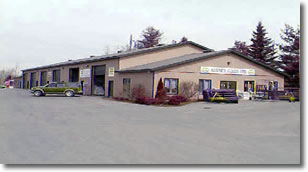 rods will accomplish this requirement. If your soil
is dry, you will require a modification to your grounding
technique. Choice of electric fencing for pastures and paddocks
is commonly a classical working fencing option. In public
access to training areas, paddock, etc. try to diminish the
chances of spooking a horse and causing injury to a person
or animal by using cutoff switches when appropriate. rods will accomplish this requirement. If your soil
is dry, you will require a modification to your grounding
technique. Choice of electric fencing for pastures and paddocks
is commonly a classical working fencing option. In public
access to training areas, paddock, etc. try to diminish the
chances of spooking a horse and causing injury to a person
or animal by using cutoff switches when appropriate.
As horse owners, a safe fence is a necessity for your horse,
visitors and neighbours. A decision to plan a layout and choose
effective options to meet your needs is an excellent starting
pint. Whether your fence requirements are permanent or temporary,
there are options. Of course other considerations like lightning
arresters to be aware of and implemented into your plan. Next
year, when an acquaintance seeks your professional advice
on fencing tips, invite them to look at your system fence.
A fence planned with system means you can have faith in a
friendly fence. Next time you look past your horses and you
see the neighbours, just "smile and wave".
Back to Top

With all the effort you’ve put into repairing your
fences, you know your paddock pals are safe for another year.
Dreaming of open prairies, the pounding of hooves resonates
the herd’s freedom bound only by imagination and your
mended fences. Neighing interrupts your quiet evening as Shadow
calls out to you. You nod, silently telling her its okay.
In turn, she throws her head and returns to her rank. Watching,
you decide it is easier to have planned to enjoy the summer
equine experience than fight it.
No matter how much you plan, the grass is always greener
on the other side. Through hunger or challenge, those stems
of fresh pure grass wave to your horse. In a trance like state,
your horse is charmed into finding a way to the calling grass.
Under, over or through the fence, avenues are tested for least
resistance and in such circumstances, Shadow’s leaning
form bends and breaks down over the fence top. Broken boards
are avenues to injury and a necessary expense to fix. Your
summer fun equine experience has just been interrupted.
Open miles of prairies are but a memory of ancestral nature.
The freedom to choose is nature’s way for sustenance
and survival. In the terms of pasture selection, variety is
the key to happiness for you and Shadow. The ability to handle
environmental conditions like trampling, heat and regrowth,
makes a balanced pasture ecosystem logical.
Timothy, while offering great initial establishment and growth,
has low production in midsummer. Orchard grass has excellent
early season production and maintains production into midsummer
but will loose quality if allowed to mature. Tall Fescue must
be a certified seed variety for cleanliness from disease.
Tall Fescue’s contributive qualities are high yielding,
good summer and fall production and a toleration for trampling.
By combining these and other species together into a mix,
it is possible to introduce the variety that Shadow and the
barnyard gang require of their pasture.
Having chosen to rejuvenate your pasture/paddock is an inexpensive
and easy to do task. Introducing a new seed species back into
the field as early as possible in the spring, the young seedlings
sprout and grow just when the rest of the existing plants
awaken and grow. It is important that time is heeded for thicker
existing pastures; however, if there are many bare patches,
the pasture can most likely be seeded successfully. Shadow
appreciates that you take the time to watch the pasture diversity.
Identifying toxic weeds like poison hemlock, field horsetail,
tansy ragwort, buttercups, nightshade, bracken fern and St.John’s
wort, avoids some nasty reactions into the season and does
happen in Eastern Ontario!
Shadow and the herd appreciate the seasonal equine experience.
Your efforts to ensure a balanced and lasting pasture have
in likewise added to your summer’s enjoyment. Contentedly
watching Shadow, the other mare and her foal, you feel a sense
of inner satisfaction and pride. Your horses are in great
shape. Their six-acre pasture is quite adequate to carry through
the full season. You see Racer, Shadow’s new little
brother racing around the two adults. Silently, you wish you
could kick your heals like Racer; however, the peace of the
summer time experience is in itself a reward granted and appreciated.
(Information provided by Andrew Droppo, manager Rooney Feeds
Ltd.)
Back to Top

When thinking of the most beloved and trusted
of all horses, never forget the senior horse. They often refer
to older horses for being in their late teens, but now with
good nutrition, management and care, horses can live well
into their twenties. We give attention to the common problems
to extend into healthy lives.
Dental
Chewing is difficult for the older horses
when teeth are worn or missing. Poor dental care can cause
mouth ulcers resulting in pain. Poor teeth discourage
horses from chewing their food long enough. This creates
a lack of saliva production necessary for digestion and
proper lubrication of the esophagus for swallowing. Feeding
a processed feed, such as a pellet or extruded helps to
promote chewing. These feeds can also be soaked to make
a gruel to make it a more digestible selection and to
increase water consumption.
Digestive System
With age, the digestive tract begins
to weaken. Lack of activity, results in gas production
and impaction, which can lead to colic. Feeding smaller
meals more frequently helps with the digestive process.
Reducing starch or grain and replacing it with a highly
digestible fibre source helps to reduce excess gas and
impaction. Feeding beet pulp or a processed feed with
beet pulp is highly digestible for the older horse. Remember
to offer tepid water between 10-20 degrees Celsius and
free choice salt should always be available. Adding salt
to the horse's diet also helps to stimulate water consumption.
Parasite infestation hinders digestion
and in common sense you know that a proper deworming and
parasite control program should be in place.
Respiratory
Senior horses may begin to experience
some respiratory problems including heaves or chronic
obstructive pulmonary disease (COPD). Minor symptoms include
a dry cough. In severe cases, the horse may develop rapid
breathing, difficulty inhaling and exhaling and a "heave"
line along the lower sides of the abdomen. Slight changes
to feeding programs and environmental factors with medications
and herbal products can help to aid respiratory problems
along. The first step is to eliminate dust and allergens.
Feed only high quality, clean hay. Wetting or steaming
hay before feeding further eliminates any dust that may
be present. Feeding a complete feed can eliminate hay
from the diet. "Heavey" horses often thrive when living
completely outside.
Hair & Skin
An inadequate diet is often to blame
for problems with hair, skin and hooves in horses of all
ages, but is particularly evident in older horses. Often
with regular grooming and good nutrition the problem gets
resolved; however, a poor coat in elderly horses can sometimes
be due to Cushing's disease, which is caused by a tumor
in the pituitary or thyroid disjunction. Malfunctions
like an intolerance to glucose or blood sugar can cause
this. After a meal high in starch, such as cereal grains,
blood levels of glucose and insulin become abnormally
high. Horses with Cushing's disease respond well to diets
lower in starch and high in fat and fibre.
Bones & Joints
As horses begin to get older, we begin
to see lameness due to laminitis, arthritis or stiffness
from weakened bones due to demineralization. Now, many
solutions to help aid in joint discomfort like glucosamine
sulfate, glucosamine hydrochloride and chondroitin sulfate
are available. A combination that combines more than one
of these with MSM gives you a multi approach to rebuilding
both the synovial fluids and the cartilage. Other considerations
include herbal remedies like Mobility that combines the
healing and renewal properties of comfrey, burdock, dandelion,
devil's claw and yucca.
Older horses and ponies deserve all the extra
loving care. They are the ones that taught most of us to ride
and gave us the foundation of experience to move on! I would
like to thank an old pony named Spanky that lived to a ripe
old age of 37.
 13% Fat
"N" Fibre Horse Ration is formulated to be fed
to all classes of mature horses with a dietary requirement
for increased levels of fat and fibre. 13% Fat
"N" Fibre Horse Ration is formulated to be fed
to all classes of mature horses with a dietary requirement
for increased levels of fat and fibre. |
Back to Top
|

